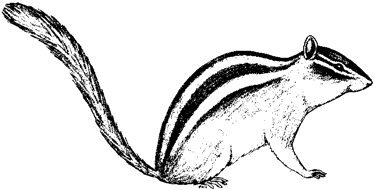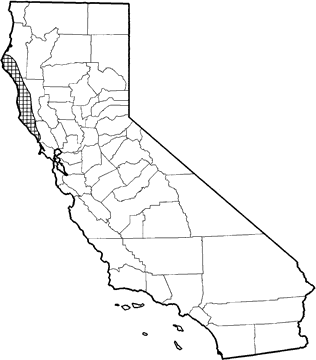
Yellow-cheeked Chipmunk
Distribution, Abundance, and Seasonality
A locally common, yearlong resident of redwood and mixed coniferous forests of the North Coast Ranges, from Humboldt Co. south to near Marin Co. Iine (Sutton and Nadler 1974). This species occurs from sea level to 915 m (0-3000 ft) elevation (Grinnell 1933).

Range Map
Specific Habitat Requirements
Feeding: No specific data found for the diet of T. ochrogenys, however, the closely related T. senex eats primarily forb, shrub, and conifer seeds, subterranean fungi, and berries and other fruits of various shrubs. They also eat some terrestrial insects. Chipmunks forage on the ground in log-strewn forests, and in adjacent chaparral habitats. They may climb the trunks and on lower branches of trees and shrubs to gather food (Johnson 1943).
Cover: These chipmunks use dense undergrowth and burrows for cover.
Reproduction: Nests are located in burrows or in trees.
Water: No data found.
Pattern: These chipmunks probably require small areas of heavy understory in brush and forest habitats (Grinnell 1933).
Species Life History
Activity Patterns: Diurnal activity. Probably hibernate from October through March or April.
Seasonal Movements / Migration: Non-migratory.
Home Range: No data found for T. ochrogenys. In Oregon, home ranges of the closely related T. townsendii varied from 0.5-1.0 ha (1.25-2.47 ac) (Gashwiler 1965).
Territory: No data found.
Reproduction: No data found for T. ochrogenys. The closely related T. senex mates from April to July; most young are born in May. One litter per yr of 4-5 young (range 3-6).
Niche: Until recently, T. ochrogenys was considered a race of T. townsendii. See Sutton and Nadler (1974); also see Burt and Grossenheider 1964 and 1976. Potential predators include spotted skunks, minks, long-tailed weasels, martens, domestic cats, great horned owls, and various hawks. Yellow-cheeked chipmunks are parapatric with T. senex to the north and T. sonomae to the east. Potential competition with ground squirrels and other ground-dwelling species with similar food and cover requirements, in part, may be reduced by T. ochrogenys' ability to use arboreal habitats.
Sources & References
California Department of Fish and Game, 1999.
California's Wildlife, Sacramento, CA.
Written by: C. Polite, T. Harvey, reviewed by: M. White, edited by: M. White
Burt, W. H., and R. P. Grossenheider. 1964. A field guide to the mammals. 2nd ed. Houghton Mifflin Co., Boston, MA. 284pp. Burt, W. H., and R. P. Grossenheider. 1976. A field guide to the mammals. 3d ed. Houghton Mifflin Co, Boston, MA. 289pp.
Gashwiler, J. S. 1965. Longevity and home range of a Townsend chipmunk. J. Mammal. 46:693. Grinnell, J. 1933. Review of the recent mammal fauna of California. Univ. Calif. Publ. Zool. 40:71-234. Johnson, D. H. 1943. Systematic review of the chipmunks (genus Eutamias) of California. Univ. Calif. Publ. Zool. 48:63-143. Meredith, D. H. 1972. Subalpine cover association of Eutamias amoenus and Eutamias townsendii in the Washington Cascades. Amer. Midl. Nat. 88:102-114. Sutton, D. A., and C. F. Nadler. 1974. Systematic revision of three Townsend chipmunks (Eutamias townsendii). Southwest Nat. 19:199-211.
California Animal Facts | California's Wildlife